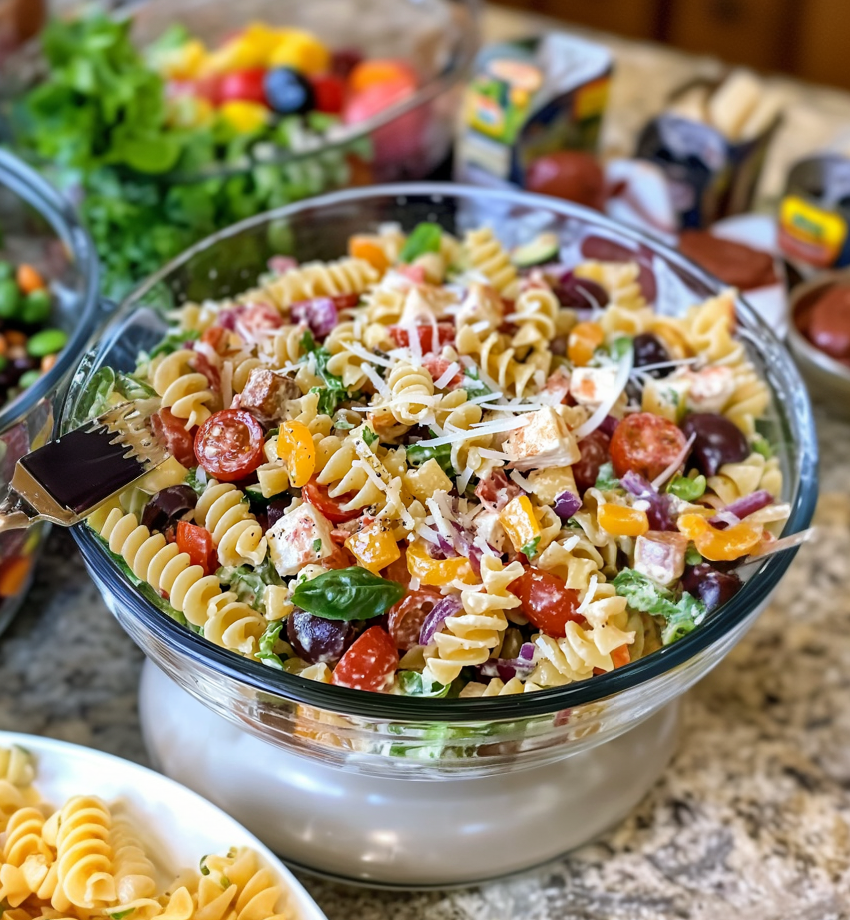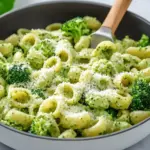This Italian Pasta Salad is a vibrant and flavorful dish perfect for summer gatherings, potlucks, or as a refreshing side. Combining tri-color rotini with crisp vegetables, salami, and cheeses, all tossed in a zesty Italian vinaigrette, it’s both visually appealing and delicious. The salad is best when made ahead, allowing the flavors to meld beautifully.
Full Recipe:
Ingredients
- 16 ounces tri-color rotini pasta
- 8 ounces salami, chopped
- 1 cup Italian vinaigrette dressing (store-bought or homemade)
- 1 cup cubed mozzarella cheese
- 1 pint grape tomatoes, halved
- ½ cup sliced black olives
- ½ green bell pepper, diced
- ½ orange bell pepper, diced
- ½ red bell pepper, diced
- ⅓ cup diced red onion
- ⅓ cup shredded Parmesan cheese
- 3 tablespoons chopped fresh parsley
- ½ teaspoon Italian seasoning
- Salt and black pepper, to taste
Directions
- Cook the rotini pasta al dente according to package instructions. Rinse under cold water to stop cooking and cool.
- In a large bowl, combine the cooked pasta, salami, mozzarella, grape tomatoes, black olives, diced bell peppers, red onion, Parmesan cheese, parsley, and Italian seasoning.
- Pour the Italian vinaigrette over the mixture and toss to combine thoroughly.
- Season with salt and black pepper to taste.
- Refrigerate the salad for at least 2 hours before serving to allow flavors to blend.
Nutritional Facts (per serving)
- Calories: 325
- Carbohydrates: 34g
- Protein: 13g
- Fat: 15g
- Saturated Fat: 5g
- Cholesterol: 24mg
- Sodium: 818mg
- Potassium: 314mg
- Fiber: 2g
- Sugar: 5g
- Vitamin A: 855 IU
- Vitamin C: 24mg
- Calcium: 104mg
- Iron: 1mg
Origins and Cultural Significance
The Italian pasta salad as we know it today is a fusion inspired by traditional Italian ingredients and American culinary creativity. While Italy itself has a deep-rooted history of pasta dishes, the cold pasta salad concept took shape mainly in the United States as a way to enjoy pasta in a refreshing, chilled form — ideal for warm weather and outdoor meals.
The salad often incorporates ingredients commonly used in Italian cuisine, such as olive oil, vinegar, cured meats like salami, fresh vegetables, and cheeses like mozzarella and Parmesan. These elements reflect the Mediterranean diet’s emphasis on fresh, wholesome foods and balanced flavors.
Italian pasta salad has since become a symbol of communal dining and celebration, frequently appearing at family gatherings, barbecues, and potlucks. Its ease of preparation, ability to serve large groups, and appealing presentation contribute to its lasting popularity.
Flavor Profile and Ingredient Harmony
What makes Italian pasta salad so irresistible is the way its ingredients harmonize. The rotini pasta provides a sturdy, chewy base that holds up well to tossing with the vinaigrette. The tri-color pasta adds visual appeal, making the dish look as vibrant as it tastes.
Salami contributes a rich, smoky, and slightly spicy note that contrasts beautifully with the freshness of the vegetables. The crisp bell peppers, juicy grape tomatoes, and briny black olives introduce layers of texture and flavor complexity. Meanwhile, the mozzarella cheese offers a mild creaminess that balances the tangy dressing.
The Italian vinaigrette dressing—typically a blend of olive oil, vinegar, herbs, and spices—is the unifying element that brings all the flavors together. It adds acidity and zest, enhancing the overall freshness of the salad without overpowering any single ingredient.
Health Benefits and Nutritional Insights
Italian pasta salad can be a wholesome addition to a balanced diet when made with quality ingredients and mindful portions. It contains a mix of carbohydrates, proteins, and fats that provide sustained energy.
The pasta delivers complex carbohydrates essential for fueling the body, while the salami and cheeses add protein and fat, which contribute to satiety and flavor. Vegetables like bell peppers, tomatoes, and onions supply vital vitamins, minerals, and antioxidants, supporting overall health.
Despite the presence of salami and cheese, which can be high in sodium and saturated fat, this salad can still be enjoyed healthfully by moderating portion sizes or substituting with leaner proteins or lower-fat cheeses. Additionally, using a homemade vinaigrette with heart-healthy olive oil can further improve the nutritional profile.
Customization and Variations
One of the most exciting aspects of Italian pasta salad is its adaptability. Home cooks can easily customize the recipe to suit personal preferences or dietary needs.
For those looking to reduce fat or calories, lean proteins such as grilled chicken or turkey can replace salami. Vegetarians can omit the meat entirely or add plant-based protein sources like chickpeas or tofu.
Cheese options can vary from creamy mozzarella to tangy feta or even vegan cheese alternatives. Vegetables are also highly flexible; adding cucumbers, artichoke hearts, or sun-dried tomatoes can introduce new flavors and textures.
Herbs and seasonings are another way to personalize the dish. Fresh basil, oregano, or a pinch of red pepper flakes can add a unique twist.
Serving Suggestions and Pairings
Italian pasta salad pairs wonderfully with many meals and occasions. It works perfectly as a side dish alongside grilled meats, seafood, or sandwiches. It’s also a great standalone light lunch or picnic meal, especially when chilled.
For casual gatherings, serve it in a large bowl or individual portions in mason jars for easy transport. Garnish with fresh parsley or basil to enhance presentation.
Pair this salad with refreshing beverages such as iced tea, lemonade, or even a crisp white wine for a complete meal experience.
Tips for Preparing the Perfect Italian Pasta Salad
To achieve the best results, cooking the pasta just right is essential—it should be al dente, firm yet tender, to avoid becoming mushy after chilling.
Rinsing the cooked pasta under cold water helps stop the cooking process and cools the pasta for mixing with other ingredients.
Allowing the salad to rest in the refrigerator for at least a couple of hours or overnight is crucial. This resting time lets the flavors meld together, creating a more cohesive and tasty dish.
When preparing in advance, it’s best to dress the salad closer to serving time or store the dressing separately to keep ingredients crisp.
Why Italian Pasta Salad is Perfect for All Seasons
While it’s often associated with summer and outdoor meals, Italian pasta salad’s appeal extends year-round. Its fresh ingredients and zesty dressing are refreshing in hot weather, while its hearty components like salami and cheese provide comfort during cooler months.
This balance of lightness and richness makes it suitable for many types of meals, whether as a picnic treat, a family dinner side, or part of a holiday buffet.
Conclusion
Italian pasta salad is much more than just a simple dish; it’s a celebration of flavor, texture, and culture wrapped into one colorful bowl. Its flexibility and ease of preparation make it a favorite for home cooks and entertainers alike.





